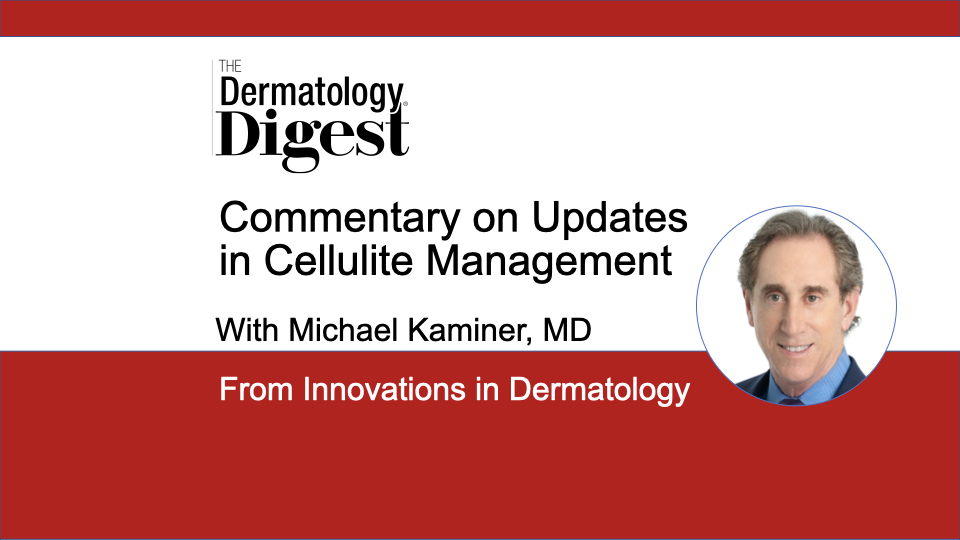Dr. Michael Kaminer discusses what’s new and what works in cellulite treatment, including research insights, specific devices, and an individualized patient approach.
Michael Kaminer, MD, Associate Clinical Professor of Dermatology, Yale Medical School, New Haven, Connecticut
“I think one of the things that’s new in cellulite is we have a much better understanding of what the cause is, or at least the primary cause,” said Michael Kaminer, MD, who presented “Updates in Cellulite Management” at the second annual Innovations in Dermatology Fall meeting in Las Vegas.
“There are three buckets, or three camps, I like to talk about: There is the skin camp, the fat camp, and the fibrous septae camp.”
Of these, research has shown fibrous septa are the primary culprit in cellulite, said Dr. Kaminer.
“We know this because there are some treatments that have come out over the past 8 to 10 years that have focused on the fibrous septa. Because of the success and longevity of results, it’s starting to really add some gravitas and some weight to focusing on fibrous septa.”
Moreover, decades of anatomy work, first performed in the 1970s by Nürnberger and Müller1 and built upon by others, including Sebastian Cotofana,2-4 helps to elucidate why women have cellulite and men do not, said Dr. Kaminer.
“So now that we know that we can focus on fibrous septa, we’re starting to see a lot of success with cellulite treatments.”
There are a few ways to target the fibrous septa in the treatment of cellulite, said Dr. Kaminer.
“You can cut them, which is what we call mechanical subcision, and there are a few treatments on the market that do that. You can try and dissolve them with chemicals—chemical subcision with collagenase.”
Dr. Kaminer notes that Endo International announced December 6, 2022, that it was ceasing production and sales of its Qwo (collagenase clostridium histolyticum-aaes) device due to market concerns about the extent and variability of bruising following initial treatment as well as the potential for prolonged skin discoloration.
“Or you can try and dissolve them with sound waves, or acoustic subcision, using a device that Allergan now owns that deploys sound waves to break up the fibrous septa.”
All these treatments aim to provide the same long-term benefit, said Dr. Kaminer.
Treatment Approach
According to Dr. Kaminer, starting with an evaluation of the patient’s cellulite helps to create a customized treatment approach, including which therapy is best to use first and whether combination treatment is warranted.
“There’s a lot of different kinds of cellulite. Dimples can be small or large, single or multiple. Some patients have more rippled cellulite, which tends to be on the legs.”
Applying knowledge generated from anatomical research, dermatologists have a better understanding of what’s causing cellulite and which treatments to use first, he said.
“In many cases, just a single treatment makes people happy. The data for most of these [treatments] indicate that 95% of patients will see a benefit. Even a small amount of improvement makes people happy. It doesn’t have to be perfect.”
Several devices offer mechanical subcision and provide visible benefit right away, said Dr. Kaminer.
“Cellfina was the first in that group. That’s been around now for several years. Efficacy in published data [is] out beyond five years. Now Aveli [Revelle Aesthetics] has come to the market, another device FDA cleared for the long-term improvement of cellulite, [which] also does mechanical subcision with durable results out beyond a year.”
Another device, Resonic (Rapid Acoustic Pulse, Allergan), uses sound waves to dissolve fibrous septae.
“Again, same kind of efficacy data: 95% of people will see a benefit that they are pleased with, and the advantage of Resonic is there’s no downtime, there’s an immediate recovery, there’s no bruising, nothing like that. So Resonic, as it becomes more widely available, may become a primary treatment, sort of a starter treatment. And then you may follow that on to clean up with something like Aveli or Cellfina.”
Biostimulators can also be used to hide cellulite, said Dr. Kaminer.
“There’s a couple of products on the market, Radiesse (calcium hydroxylapetite, Merz) and Sculptra (poly-L-lactic acid, Galderma). You can use them in hyperdilute forms. They both work beautifully, especially for that wavy cellulite.”
For patients who would like to continue to refine results, think about combining treatments, said Dr. Kaminer.
“I personally tend to perform the more long-lasting treatments first, whether it be with Resonic, Aveli, or Cellfina, and then tidy up with one of the biostimulators…”
Biostimulators can last a year and a half or longer after a couple of treatments, said Dr. Kaminer.
“So there’s definitely a biostimulatory component, hence the name, that makes it a bit more of a long-lasting result as the patients build their own collagen and elastic tissue and they start to see the smoothness that they’re looking for.”
Disclosure: Dr. Kaminer is a consultant for Revelle Aesthetics and Allergan and conducts research for Galderma.
References:
- Nürnberger F, Müller G. So-called cellulite: an invented disease. J Dermatol Surg Oncol. 1978 Mar;4(3):221-9. doi: 10.1111/j.1524-4725.1978.tb00416.x. PMID: 632386.
- Whipple LA, Fournier CT, Heiman AJ, Awad AA, Roth MZ, Cotofana S, Ricci JA. The Anatomical Basis of Cellulite Dimple Formation: An Ultrasound-Based Examination. Plast Reconstr Surg. 2021 Sep 1;148(3):375e-381e. doi: 10.1097/PRS.0000000000008218. PMID: 34432683.
- Whipple LA, Fournier CT, Heiman AJ, Awad AA, Roth MZ, Cotofana S, Ricci JA. The Anatomical Basis of Cellulite Dimple Formation: An Ultrasound-Based Examination. Plast Reconstr Surg. 2021 Sep 1;148(3):375e-381e. doi: 10.1097/PRS.0000000000008218. PMID: 34432683.
- Cotofana S, Kaminer MS. Anatomic update on the 3-dimensionality of the subdermal septum and its relevance for the pathophysiology of cellulite. J Cosmet Dermatol. 2022 Aug;21(8):3232-3239. doi: 10.1111/jocd.15087. Epub 2022 Jun 2. PMID: 35569133.
[KM1]Qwo has recently been taken off the market


